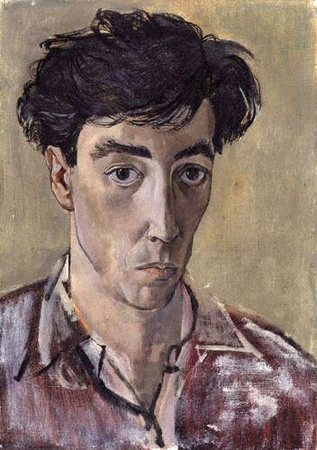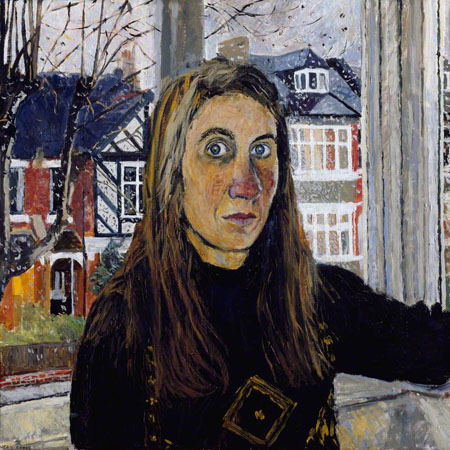|
JOHN MINTON: A CENTENARY
An exhibition at the Pallant House Gallery, Chichester, 1st July to 1st October,
2017
JOHN MINTON: A CENTENARY
By Simon Martin and Frances Spalding
Pallant House Gallery. 128 pages. £24.95. ISBN 978-1-8698-2786-1
A DIFFERENT LIGHT: BRITISH NEO-ROMANTICISM
An exhibition at the Pallant House Gallery, Chichester, 10th June to 24th
September, 2017
JEAN COOKE: DELIGHT IN THINGS SEEN
An exhibition at the Jerwood Gallery, Hastings, 24th May to 10th
September, 2017
Reviewed by Jim Burns


Artists are sometimes remembered by the majority of people more for
their links to other painters and places than for their own work.
John Minton’s name crops up in all the books about
Soho
in the 1940s and 1950s, drinking alongside Francis Bacon and Lucian
Freud In the Colony Room, being photographed by John Deakin, and
tragically committing suicide at the age of 39. Jean Cooke was, for
many years, overshadowed by her husband, John Bratby, who abused her
in more ways than one, and was jealous of any sort of success she
had with her paintings. But it would be a pity if Minton and Cooke
were only known for their personal involvements with other artists.
Both had something of value to offer in their own right.
John Minton was born in 1917 into a middle-class family and in later
life was a trust beneficiary, so “was never dependent purely on his
art, and he could be remarkably generous to his friends”. He had a
good education, and in 1936 was awarded s scholarship at the St John’s Wood
Art School.
He exhibited at the Westheim Gallery in London
in 1938, and thanks to his private income he was able to spend
several months in
France
with Michael Ayrton. In 1939 he collaborated with Ayrton on designs
for a production of Dido and
Aeneas that was never realised.
The outbreak of war in 1939 found Minton at first attempting to
register as a conscientious objector, but then enrolling for service
in the army. He continued to exhibit and worked with Ayrton on
designing sets and costumes for John Gielgud’s
Macbeth at the Piccadilly
Theatre. He was discharged from the army on health grounds in 1943,
and for the next three years shared a studio with the Scottish
artists, Robert Colquhoun and Robert MacBryde.
I don’t think it’s necessary to outline all of Minton’s activities
in the post-war period. He exhibited regularly here and there, and
contributed cover
illustrations to publications like
Penguin New Writing and
for numerous novels. The exhibition in
Chichester
includes examples of his work in this line. He also travelled to France and Spain. And taught at various
institutions, including the Royal College of Art. What also
impresses is the range of people, especially artists,
that Minton knew and mixed with. They included Lucian Freud,
Keith Vaughan, Francis Bacon, the two Roberts, Rodrigo Moynihan,
Richard Chopping, Denis Wirth-Miller, and many others. The
Soho
bohemia of the late-1940s and 1950s was, in many ways, his natural
habitat when he wasn’t teaching or painting.
Minton’s seeming gregariousness and love of drinking and dancing may
well have been signs of a basically insecure disposition that led to
his suicide in 1957. Minton was openly homosexual at a time when it
was a criminal offence and the police were actively attempting to
entrap men into committing acts that would lead to their arrest.
There is a dark painting in the exhibition that shows a figure
loitering in the shadows as if in anticipation of some sort of
assignation, or encounter, no matter how dangerous.
The material on show in Chichester
encompasses a broad sample of Minton’s work, from colourful
paintings, to some splendid pen and ink drawings, to illustrations
for magazines and books, and film posters. And it’s especially
encouraging to see that his skills as an illustrator are given their
fair share of attention. There may be a tendency, in certain
circles, at least, to relegate book and magazine covers, and other
forms of what some will consider tantamount to advertising matter,
to a lower category than canvases, but it strikes me as unfair if
that Is the case.
There is much to be gained from looking at an apt jacket design for
a novel, and Minton had a flair for such things. It may be that his
best-known book covers are those he did for some Elizabeth David
cook books, and that those for what are, in many cases, fairly
obscure and forgotten novels, are consequently destined to be
overlooked. But there are sufficient of them in the exhibition to
persuade a fair-minded observer that Minton excelled at illustrating
a variety of subjects.
With regard to his paintings, they often have an immediate impact
because of their bright colours, particularly when Minton travelled
to Corsica or
Jamaica. But there are also some
London
scenes from 1946/47 in which, the catalogue suggests, “the strong
colours suggest neither daytime nor night”. They certainly don’t
adhere to a popular notion of post-war
Britain
as a grey and dismal place, though it has been suggested that they
do point to a decline in the country’s fortunes, with its industrial
base shattered. The picturesque is ultimately going to take over
from the commercially busy. And the skies appear to indicate
impending storms.
By 1957 or so tastes in art were beginning to change. Abstraction
was coming to the fore and in 1956 the Tate staged a show of
American Abstract Expressionism.
Minton was strongly opposed to abstraction, and it could have
been that an awareness that his style of painting was being
overtaken and likely to go out of fashion, combined with his
alcoholism and his chaotic personal life, pushed him into suicide.
For a deeper consideration of Minton’s mental state at the time of
his death I’d recommend Frances Spalding’s
Dance till the Stars Come
Down: A Biography of John Minton (Hodder & Stoughton, 1991). It
could also be useful to read the chapter on Minton in Malcolm
Yorke’s The Spirit of Place:
Nine Neo-Romantic Artists and their Times (Constable, 1988).
Back in 1987, when I saw the exhibition,
A Paradise Lost: The
Neo-Romantic Imagination in
Britain
1935-55 at the Barbican, John Minton had a prominent place in
it. For obvious reasons he’s not included among the Neo-Romantic
artists like MacBryde, Colquhoun, John Craxton, John Piper, Paul
Nash, and several more, on show in Chichester. It’s instructive,
though, to have a look at their work in order to see the kind of
context Minton was operating in. In 1987 it was suggested that
Neo-Romanticism had been “repressed and edited out of the history of
British art and culture”, and it was true that abstraction and Pop
Art and other post-1960 movements had more or less consigned
Neo-Romanticism to, if not the dustbin, then the storage room of
history.
It’s good that recent years have seen the paintings being brought
out and put on display again. I’ve seen an exhibition of Colquhoun
and MacBryde in Edinburgh, another of Robin Ironside in
Chester, and earlier this year there was an exhibition,
The Romantic Impulse: British
Neo-Romantic Artists at Home & Abroad 1935-1959 at the
Osborne Samuel Gallery
in London.
An informative catalogue was published in connection with the
exhibition.
If Neo-Romanticism is “a difficult term to define”. and its
“boundaries and content” have more to do with “a spirit of place”
and an “impulse to convey a sense of Britishness”, then this might
be a useful time for looking again at the work of Minton, Craxton,
Leslie Hurry, Prunella Clough, and their contemporaries, not just to
set the historical record right, but also to highlight the work of
several imaginative artists. They can be looked on as members of a
loosely-defined group, but perhaps more as individuals with
characteristic, and sometimes similar, content (“the lyrical….the
mystical, the romantic, and the preoccupation with linear
rhythms….”) in their paintings.
Jean Cooke can’t be grouped with the Neo-Romantics, but she’s a
neglected figure and deserves to be recognised for her own work and
not just because she was at one time married to the roaring boy of
the British art world, John Bratby. Life with him wasn’t easy and he
wasn’t averse to painting over her canvases, and even damaging
something of hers that he didn’t approve of. Bratby was, of course,
the leading light of the so-called “kitchen-sink” school of artists,
and even when he allowed her to paint he tried to get her to adhere
to that style.
There is a 1958 painting by Jean Cooke in the Hastings exhibition, and
it is very much akin to what John Bratby was doing. It shows him
looking through an open window into the kitchen from outside. It has
all the acknowledged signs of a “kitchen-sink” canvas, the bottles
and packets, the glimpse of a sink. A later
portrait of Bratby has him white-bearded and looking rather glum.
Perhaps it was payback time for when he forced her act as his model
and, to suit the kitchen-sink image, usually made her appear
downtrodden and miserable, which she most likely was, anyway.
When she finally broke away from Bratby she left the kitchen sink
behind, and had a reasonably successful career under her own name.
The exhibition has some attractive nature scenes set in gardens and
woods, and one or two conventional but likeable portraits. Jean
Cooke wasn’t a major painter, but she could be an interesting one.
The critic Andrew Lambirth said: “A characteristic Cooke painting
takes the real world and views it from a slightly odd angle – as if
musingly with head on one side”. It’s an accurate description of her
approach to painting.
|